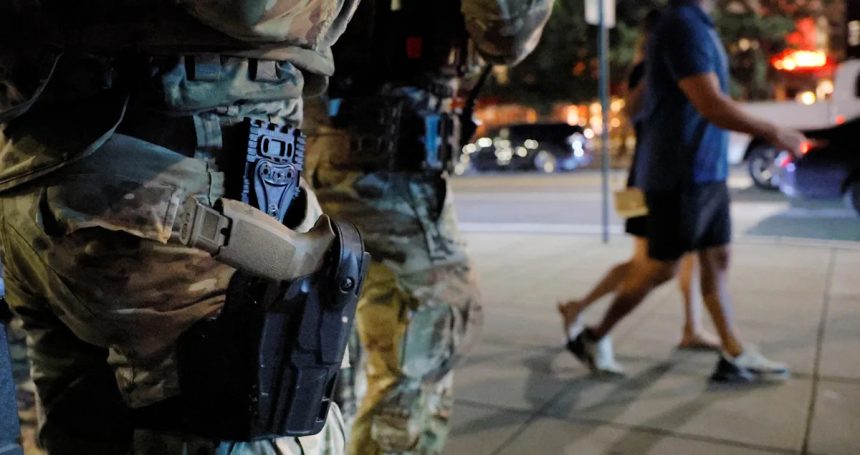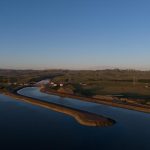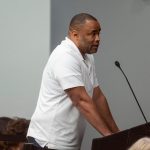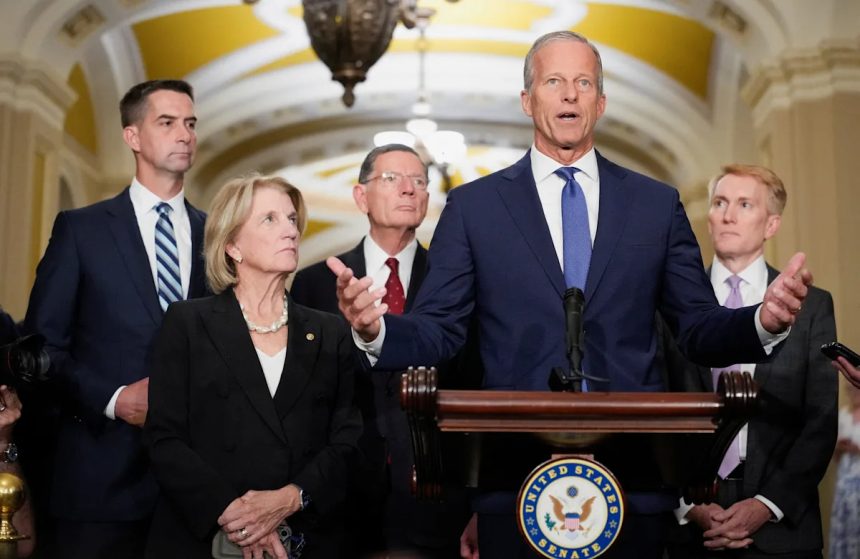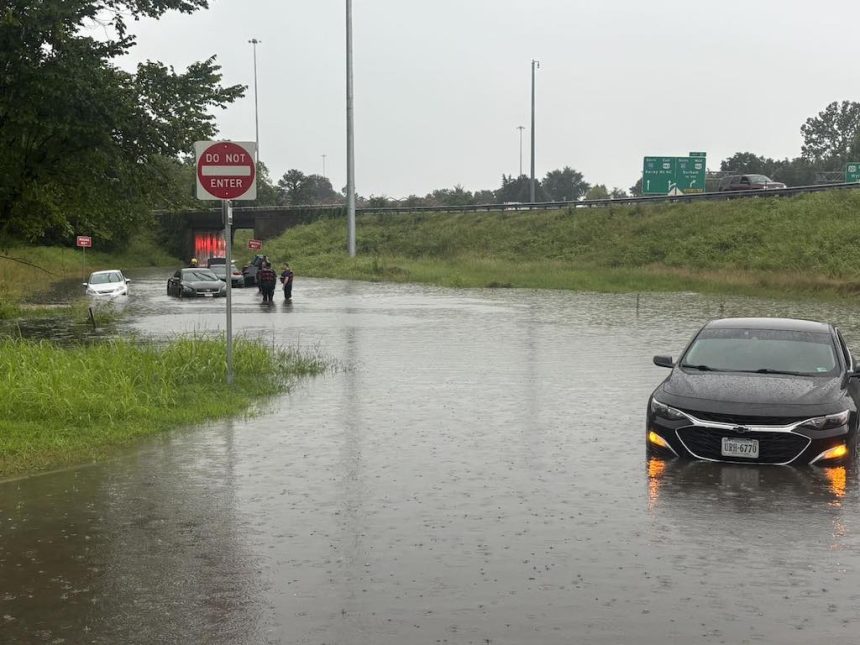As the 2,200 National Guard troops deployed to Washington, D.C., begin to carry firearms on patrol, President Trump is now threatening — and, according to at least one report, actively planning — to expand his domestic use of military force into other cities over the objections of local officials.
Chicago and Baltimore are in the spotlight.
“Chicago’s a mess,” the president said Friday. “And we’ll straighten that one out probably next. That’ll be our next one after this. And it won’t even be tough.”
On Sunday, the Washington Post reported that “the Pentagon has for weeks been planning a military deployment to Chicago,” which could involve “mobilizing at least a few thousand members of the National Guard as soon as September” or even “the use of thousands of active-duty troops.”
In response, Chicago Mayor Brandon Johnson, a Democrat, said the city was “currently evaluating all of our legal options to protect the people of Chicago from unconstitutional federal overreach.”
“No matter what happens, the City of Chicago will not waver,” Johnson added. “We are Chicago. We will not bend or cower, and we will never break.”
Trump, for his part, has repeatedly called Johnson “incompetent.”
Meanwhile, a similar situation has been unfolding in Baltimore after Maryland Gov. Wes Moore — a Democrat and a frequent critic of Trump’s actions in nearby Washington, D.C. — formally invited the president to the state for a public safety walk next month.
Instead of accepting the invite, Trump shot back on social media, writing that “if Wes Moore needs help, like Gavin Newscum did in L.A., I will send in the ‘troops,’ which is being done in nearby DC, and quickly clean up the Crime.”
But can Trump actually send federal forces elsewhere? Here’s everything you need to know about what the president could be planning.
What has Trump said about sending the National Guard into other cities?
The president has repeatedly hinted that he might try to use his D.C. playbook in other places.
In fact, as soon as Trump announced earlier this month that he was mobilizing National Guard troops in the nation’s capital to crack down on what he described as “crime, bloodshed, bedlam and squalor,” he issued a warning to other cities around the country as well.
“We’re going to take back our capital,” Trump said. “And then we’ll look at other cities also.”
The president went on to single out Chicago, Los Angeles, New York, Baltimore and Oakland, Calif., as “other cities also that are bad, very bad.”
“They’re so far gone,” he continued. “We’re not going to let it happen. We’re not going to lose our cities over this. And this will go further. We’re starting very strongly with D.C. and we’re going to clean it up real quick, very quickly, as they say.”
Beyond that, the president didn’t elaborate on his plans. But he did issue what amounted to an ultimatum: “Self-clean up” or else.
“Other cities are hopefully watching this,” Trump said. “Maybe they’ll self-clean up, and maybe they’ll self-do this.”
But “if they don’t learn their lesson, if they haven’t studied us properly,” he continued, “then I’m going to look at New York in a little while. … And if we need to, we’re going to do the same thing in Chicago, which is a disaster.”
On Friday, Trump again mentioned Chicago and New York — suggesting that actual planning might already be underway (per the Washington Post report).
“I think Chicago will be our next,” Trump told reporters at the White House. “And then we’ll help with New York.”
What does the law say about Trump’s plans?
Trump’s actions in Washington, D.C., are legal. As you may remember from elementary school, D.C. isn’t a state. It isn’t part of any other state either. It doesn’t have a constitution of its own. Instead, D.C. is what’s known as a “federal district,” and it’s been mostly under the jurisdiction of the U.S. Congress since its founding in 1791.
In 1973, Congress passed the Home Rule Act, which allowed D.C. residents to elect their own mayor and council members. But the law doesn’t give D.C. complete autonomy. Even now, Congress controls its budget. Congress also has the power to review and block local legislation.
The president, meanwhile, still appoints D.C.’s judges — and he still leads its National Guard. He can also take control of the District’s police force by invoking Section 740 of the Home Rule Act, which is precisely what he did earlier this month.
But Trump doesn’t have the same powers across the rest of the country. Under current law, governors are in charge of each state’s National Guard and the police are largely controlled locally.
Trump has already challenged some of these rules. Over the objections of state and local officials, he deployed nearly 5,000 National Guard members and U.S. Marines to Los Angeles in June after a new round of ICE workplace raids sparked protests marred by sporadic violence.
California Gov. Gavin Newsom swiftly sued the administration to end the mobilization, claiming that Trump was violating the Posse Comitatus Act of 1878, which prohibits the president from deploying the armed forces to participate in domestic law enforcement operations unless he declares that an insurrection is underway.
A federal judge agreed with Newsom, but an appeals court blocked that ruling.
Two weeks ago, Trump and Newsom faced off in a three-day trial in San Francisco to determine whether Trump has the authority to do what he did in L.A. in other cities such as Chicago and New York.
The state of California asked District Judge Charles Breyer for an injunction that would allow the military to protect federal property but block it from continuing to support immigration enforcement operations, which the state’s lawyer called an “unlawful military crusade,” according to CBS News.
During arguments, Breyer seemed skeptical of several of the Trump administration’s assertions — particularly what he called the apparent “absence of any limits to a national police force.”
Breyer is currently deliberating on the case. A ruling is expected any day now.
What does Trump hope to accomplish by mentioning other cities?
Whether the president sends federal forces into other cities remains to be seen; much depends on the outcome of the current trial in California (and any subsequent appeals).
In the meantime, Trump has been clear: He wants to pressure Democratic-run cities to change certain policies he disagrees with.
One policy he has mentioned is cashless bail, which eliminates the requirement for defendants to pay money to be released from jail before their trial. Supporters say the policy addresses disparities in the justice system, where those who can afford bail are released while those who cannot remain incarcerated; critics (like Trump) say that it puts the public at risk by releasing potentially dangerous individuals back into the community.
Maybe other cities will “get rid of the cashless bail thing and all of the things that caused the problem,” Trump said earlier this month. “I mean, if you go back, this whole thing with cashless bail is a disaster. So many problems came that we never had before.”
Trump has also threatened to withhold federal funds in order to put pressure on local leaders, much as he has done with private universities.
“I gave Wes Moore a lot of money to fix his demolished bridge,” Trump wrote Sunday on social media, referring to efforts to replace the Francis Scott Key Bridge, which collapsed in 2024. “I will now have to rethink that decision???”
The federal government had previously agreed to pay for a new bridge.
Moore slammed Trump’s message, saying in a statement that “any threats to this funding will cause irrevocable damage to the national economy and to the entire State of Maryland.”
“We have already begun rebuilding,” Moore added, “and now that Maryland is showing great progress, our President is threatening to intentionally harm Maryland.”
Have local officials pushed back?
Yes. As Yahoo News reported earlier this month, “the president’s description of crime in Washington, D.C., is not reflected in official statistics, which show that the city had its lowest violent crime rate in over 30 years in 2024. The rates of homicide, sexual abuse, assault with a dangerous weapon and robbery all fell by at least 25% compared to 2023, according to statistics from the U.S. attorney’s office for the district.”
Citing such numbers, D.C. Mayor Muriel Bowser has increasingly questioned Trump’s motives, framing his takeover as an “authoritarian push.”
“Our police department has been consistently, precipitously driving down crime,” Bowser said at a news conference on Thursday, calling the department’s work “effective.” She then added that federal troops have been “almost exclusively focused on immigration enforcement and homeless encampment enforcement,” rather than crime.
“I’ll let you draw your own conclusions,” Bowser said.
Both Moore and Johnson have followed Bowser’s lead.
“The Guard is not needed,” Johnson told NBC News on Sunday. “This is not the role of our military. The brave men and women who signed up to serve our country did not sign up to occupy American cities.”
Speaking to CNN, Moore said Trump is using the military as a “tool” for political purposes.
“I take very seriously about how, when and why I deploy members of our National Guard in cases of emergency and in true crises,” said Moore, who served in Afghanistan. “And I will not authorize the usage of Maryland National Guard forces for missions that I do not deem to be either mission critical or mission aligned.”
The U.S. Conference of Mayors has responded to Trump’s actions and statements by touting a “nationwide success story” of plummeting crime rates. An FBI report released Aug. 5 found that between 2023 and 2024, violent crime nationwide dropped by 4.5%, with murder and nonnegligent manslaughter falling by nearly 15%.
“Ultimately, the best public safety outcomes are delivered by local police departments and local officials, who know the communities,” Oklahoma City Mayor David Holt, president of the mayors’ conference, said in a statement. “America’s mayors never see takeovers by other levels of government as a tactic that has any track record of producing results.”

